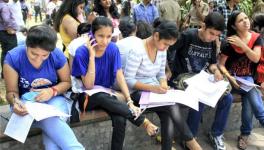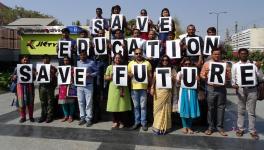Lack of Govt Primary Schools Force People to Pay More for Education
Image for representational use only.Image Courtesy : time8.in
One of the oldest government schools in Bikaner, Rajasthan, is housed in a palatial building. When one enters the building, they are faced with sandstone arches. The principal proudly proclaims that it is one of the two big government schools in the city. Upon entering the building, however, one is faced with dark classrooms surrounded by dilapidated walls. The windows are closed tightly shut, and the furniture is battered. It makes one wonder, how do the children study in classrooms like this?
According to the Unified District Information System for Education (U-DISE) 2016-2017, there were a total of 12,35,598 schools across the country that offer primary education. Among these, 9,04,300 are government schools, while the remaining 3,31,298 are private schools and madrasas, which is to say 78.13% of the primary schools are public-funded. Looking at the numbers, one may assume that the state of public-funded primary education system in India is quite good, as a majority of the government schools are run by the state.
However, as one looks deeper into the numbers given by U-DISE, the picture that is revealed is quite different. Even though almost four-fifths of the total schools offering primary education are run by the government, the enrolment in these schools is only 56.78% of the total enrolments in primary schools across the country. 40.06% of the enrolments are in private schools, while 3.16% of the enrolments are in madrasas and unrecognised schools.
There are several factors that have caused this imbalance between the government and private schools. On an average, the number of enrolments per government primary schools across the country is 100.16, while average enrolments per private primary school is 221.85. Factors like unequal distribution of schools, unavailability of trained teachers and accessibility play major roles are the reasons why more and more people are forced to send their children to private schools.
Unequal distribution of schools
As per U-DISE data, 92.9% of the government primary schools are located in rural areas, which is to say that the urban poor rarely have access to public-funded elementary education. The urban population in India has been constantly increasing. As per 2011 census, the urban population of India stood at 31.16%. As more and more people migrate to urban areas in search of livelihood, they are forced to send their children to private schools as there are just not enough number of government schools in these areas. 39.39% of the private primary schools are located in urban areas.
88.46% of the enrolments in government schools are in rural areas, while for private schools, the amount is 50.70%. This also shows that people in the rural areas who can afford giving their children private education more often than not prefer to do that, despite having enough public schools in the area.
Lack of Infrastructure and teachers
According to U-DISE, there are schools, though not many, that are still functioning with just one teacher, or just one classroom, or both. The number of schools functioning with only one classroom across the country is 51,294. The number is particularly high in certain states like Assam, Andhra Pradesh, and West Bengal, where the number of schools performing with only one teacher are 11,675, 7,779, and 4,372 respectively.
The number of schools functioning across the country with only one teacher is shockingly high, at 88,631. Again, the condition is particularly bad in certain states like Madhya Pradesh, Rajasthan, and Uttar Pradesh, where the number of schools running with only one teacher are 13,139, 13,013, and 8,562 respectively.
It’s also notable that the percentage of professionally qualified teachers in private schools is significantly higher than that in government schools. According to U-DISE, 78.87% of the teachers working in private schools are professionally qualified for their jobs. While the number is a much higher 89.01% for regular teachers working in government schools, the picture is different in case of contractual teachers. 2,16,968 out of the 6,60,508 teachers, that is, 32.85% of the contractual teachers working in the government schools have not been trained.
The Bigger Picture
The U-DISE data, however, does not list the number of posts lying vacant in government schools across the country. Neither does is talk about how the contractual teachers often do not get paid for months, and how unavailability of government schools in urban areas create an economic burden on the migrant workers and the urban poor.
When questioned about the number of vacant posts for teachers in government schools, the Minister for Human Resource Development Ramesh Pokhriyal said in the Parliament, “Education is in the Concurrent List of the Constitution, therefore, majority of the schools are under the jurisdiction of the respective State and Union Territory (UT). Hence, the recruitment, service conditions and redeployment of teachers are primarily in the domain of the respective State Government and UT Administration.”
However, even though the minister would like us to believe that the data regarding shortage of teachers is not available, a similar question was answered by the previous HRD State Minister Satya Pal Singh in the Rajya Sabha on December 13, 2018. According to the data given by the minister, 9,00,316 posts, that is 17.64% of the sanctioned posts for teachers in primary schools remained vacant.
In the recent years, contractual teachers have time and again protested across the country, in states like Jharkhand, West Bengal, Punjab, demanding regularisation and payment of their dues. Regarding this, the minister said, “The State Government or the local authority, as the case may be, shall notify terms and conditions of service and salaries and allowances of teachers in order to create a professional and permanent cadre of teachers. Accordingly, State and UT Government which are the ‘appropriate Government’ under the RTE Act, have formulated their own RTE Rules for implementation of the provisions of the RTE Act.”
The NDA government has been known to avoid questions by shifting the responsibilities to state government, to avoid being held accountable for anything. However, this makes one wonder, if the central government refuses to accept the responsibility to ensure that the children of this country receive a quality education, who will one hold accountable?
Get the latest reports & analysis with people's perspective on Protests, movements & deep analytical videos, discussions of the current affairs in your Telegram app. Subscribe to NewsClick's Telegram channel & get Real-Time updates on stories, as they get published on our website.
























